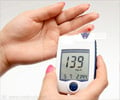When metformin monotherapy is inadequate for type 2 diabetes mellitus patients; linagliptin in combination with metformin is as efficacious as, but safer than, glimepiride.

The clinical trial was conducted at 209 sites, across 16 countries, for 104 weeks in type 2 diabetes patients aged 18-80 years. The enrolled patients were receiving ≥1500 mg/day metformin with another oral anti-diabetic drug such as 5 mg linagliptin (777 patients) or 1-4 mg glimepiride (775 patients) once-a-day. The alterations in glycated hemoglobin A1c (HbA1c) levels were the primary endpoint, measured from baseline to week 104.
Declines in average HbA1c was comparable in linagliptin (-0·16%) and glimepiride groups (-0·36%), but the overall incidence of any drug-related adverse events was lower in patients treated with linagliptin.Fewer linagliptin-treated patients had hypoglycaemia (7%) and cardiac episodes (12) as compared with glimepiride-treated patients (36% and 26). Severe hypoglycemia was reported in 1 linagliptin patient as compared to 12 glimepiride patients. Weight gain reduced in the linagliptin group (-1·4 kg) but rose in glimepiride group (1·3 kg).
Thus linagliptin is as efficacious as, but safer than, glimepiride as a treatment choice for type 2 diabetes mellitus patients for whom metformin monotherapy is inadequate. The linagliptin plus metformin combination therapy should be considered in type 2 diabetes treatment.
Reference:
2-year efficacy and safety of linagliptin compared with glimepiride in patients with type 2 diabetes inadequately controlled on metformin: a randomized, double-blind, non-inferiority trial; Baptist Gallwitz et al; The Lancet Online Publication 2012
Source-Medindia















